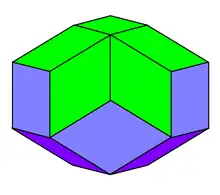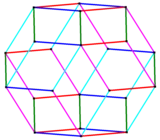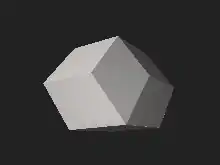Rhombic icosahedron
The rhombic icosahedron is a polyhedron shaped like an oblate sphere. Its 20 faces are congruent golden rhombi;[1] 3, 4, or 5 faces meet at each vertex. It has 5 faces (green on top figure) meeting at each of its 2 poles; these 2 vertices lie on its axis of 5-fold symmetry, which is perpendicular to 5 axes of 2-fold symmetry through the midpoints of opposite equatorial edges (example on top figure: most left-hand and most right-hand mid-edges). Its other 10 faces follow its equator, 5 above and 5 below it; each of these 10 rhombi has 2 of its 4 sides lying on this zig-zag skew decagon equator. The rhombic icosahedron has 22 vertices. It has D5d, [2+,10], (2*5) symmetry group, of order 20; thus it has a center of symmetry (since 5 is odd).
| Rhombic icosahedron | |
|---|---|
 | |
| Type | zonohedron |
| Faces | 20 congruent golden rhombi |
| Edges | 40 |
| Vertices | 22 |
| Faces per vertex | 3, 4, or 5 |
| Dual polyhedron | irregular-faced pentagonal gyrobicupola |
| Symmetry | D5d = D5v, [2+,10], (2*5) |
| Properties | convex, zonohedron |
Even though all its faces are congruent, the rhombic icosahedron is not face-transitive, since one can distinguish whether a particular face is near the equator or near a pole by examining the types of vertices surrounding this face.
Zonohedron
The rhombic icosahedron is a zonohedron, that is dual to a pentagonal gyrobicupola with regular triangular, regular pentagonal, but irregular quadrilateral faces.
The rhombic icosahedron has 5 sets of 8 parallel edges, described as 85 belts.
 |
The edges of the rhombic icosahedron can be grouped in 5 parallel-sets, seen in this wireframe orthogonal projection. |
The rhombic icosahedron forms the convex hull of the vertex-first projection of a 5-cube to 3 dimensions. The 32 vertices of a 5-cube map into the 22 exterior vertices of the rhombic icosahedron, with the remaining 10 interior vertices forming a pentagonal antiprism.
In the same way, one can obtain a Bilinski dodecahedron from a 4-cube, and a rhombic triacontahedron from a 6-cube.
Related polyhedra
The rhombic icosahedron can be derived from the rhombic triacontahedron by removing a belt of 10 middle faces.
 A rhombic triacontahedron can be seen as an elongated rhombic icosahedron. |
 The rhombic icosahedron and the rhombic triacontahedron have the same 10-fold symmetric orthogonal projection. (*) |
(*) (For example, on the left-hand figure):
The orthogonal projection of the (vertical) belt of 10 middle faces of the rhombic triacontahedron is just the (horizontal) exterior regular decagon of the common orthogonal projection.

References
- Weisstein, Eric W. "Rhombic Icosahedron". mathworld.wolfram.com. Retrieved 2019-12-20.